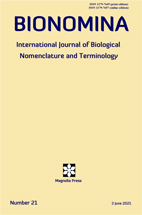Abstract
Sunagar et al. (2021: 1) erected the new snake species Bungarus romulusi on the basis of the molecular study of mitochondrial markers, venom proteomics and venom gland transcriptomics. Unfortunately, this new specific nomen is nomenclaturally unavailable, and should therefore not be used as valid as long as it has not been properly published.
References
Anonymous [International Commission on Zoological Nomenclature] (1999) International code of zoological nomenclature. ‘Fourth edition’. London (International Trust for zoological Nomenclature): i–xxix + 1–306.
Anonymous [International Commission on Zoological Nomenclature] (2012) Amendment of Articles 8, 9, 10, 21 and 78 of the International Code of Zoological Nomenclature to expand and refine methods of publication. Bulletin of zoological Nomenclature, 69 (3): 161–169. <https://doi.org/10.21805/bzn.v69i3.a8.161>.
Bauer, A. M., Parham, J. F., Brown, R. M., Stuart, B. L., Grismer, L., Papenfuss, T. J., Böhme, W., Savage, J. M., Carranza, S., Grismer, J. L., Wagner, P., Schmitz, A., Ananjeva, N. B. & Inger, R. F. (2010) Availability of new Bayesian-delimited gecko names and the importance of character-based species descriptions. Proceedings of the royal Society, (B), Biological Sciences, 278 (1705): 490‒492. <https://doi.org/10.1098/rspb.2010.1330>.
Dubois, A. (1999) Miscellanea nomenclatorica batrachologica. 19. Notes on the nomenclature of Ranidae and related groups. Alytes, 17 (1–2): 81–100.
Dubois, A. (2017) Diagnoses in zoological taxonomy and nomenclature. Bionomina, 12: 63–85. <https://doi.org/10.11646/bionomina.12.1.8>.
Dubois, A., Crochet, P.-A., Dickinson, E. C., Nemésio, A., Aescht, E., Bauer, A. M., Blagoderov, V., Bour, R., Carvalho, M. R. de, Desutter-Grandcolas, L., Frétey, T., Jager, P., Koyamba, V., Lavilla, E. O., Löbl, I., Louchart, A., Malécot, V., Schatz, H. & Ohler, A. (2013) Nomenclatural and taxonomic problems related to the electronic publication of new nomina and nomenclatural acts in zoology, with brief comments on optical discs and on the situation in botany. Zootaxa, 3735 (1): 1–94. <https://doi.org/10.11646/zootaxa.3735.1.1>.
Dubois, A., Frétey, T. & Ohler, A. (2018) The Relictus case: it is high time that taxonomists follow the Code’s requirements for nomenclatural availability and validity of new zoological nomina. Bionomina, 13: 51–64. <https://doi.org/10.11646/bionomina.13.1.4>.
Dubois, A., Ohler, A. & Pyron, R. A. (2021) New concepts and methods for phylogenetic taxonomy and nomenclature in zoology, exemplified by a new ranked cladonomy of recent amphibians (Lissamphibia). Megataxa, 5: 1‒738.
Frétey, T. & Dubois, A. (2021) It is high time that taxonomists follow the Code. 2. The Virgotyphlops case (Serpentes, Typhlopidae). Bionomina, 21: 117‒119. <https://doi.org/10.11646/bionomina.21.1.7>.
Mirza, Z. A., Gowande, G. G., Patil, R., Ambekar, M. & Patel, H. (2018) First appearance deceives many: disentangling the Hemidactylus triedrus species complex using an integrated approach. PeerJ, 6 (e5341): 1‒34. <https://doi.org/10.7717/peerj.5341>.
Sunagar, K., Khochare, S., Senji Laxme, R. R., Attarde, S., Dam, P., Suranse, V., Khaire, A., Martin, G. & Captain, A. (2021) A wolf in another wolf’s clothing: post-genomic regulation dictates venom profiles of medically-important cryptic kraits in India. Toxins, 13 (69): 1–22. <https://doi.org/10.3390/toxins13010069>.


